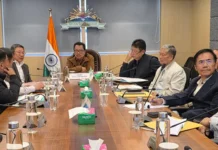[ Dr Sailajananda Saikia ]
The relationship between India and Myanmar, particularly with regard to the northeastern Indian states, has been significantly shaped by the free movement regime (FMR). In order to promote cultural and economic exchanges between communities that have familial ties across the border, the FMR was created to make it easier for residents of border areas to move about. It permitted people to enter each other’s territories up to 16 kilometres without a visa. This system was especially important for ethnic groups with longstanding ties that cut across national borders, such the Kuki and the Naga. As a result of recent events in Manipur, the FMR has been suspended, mostly due to growing security concerns over drug trafficking, illegal immigration, and insurrection. With serious concerns about the effects on local communities and regional stability, the Indian government listed these problems as crucial reasons for requiring stricter border controls. The suspension runs the danger of upsetting economic activity that is essential to border dwellers as well as breaking generation-old cultural links. It is crucial to consider the FMR’s larger historical background, its intended advantages, and the possible effects of its suspension on both sides of the border as stakeholders deal with this new reality. This is especially important, given the ongoing instability in Myanmar and its effects on the local population in northeastern India.
In order to foster trade and strengthen cultural linkages between populations along the India-Myanmar border, India’s ‘Act East Policy’ included the establishment of the FMR in 2018. This programme’s primary goal is to promote people-to-people contact, which is crucial for fostering mutual trust and collaboration amongst nearby communities. In order to enhance the standard of living for people living in border regions and support stability and growth, the FMR works to make it simpler for them to access essential services like healthcare and education.
The Kuki and Naga ethnic groups, whose kinship ties cross international borders, are specifically targeted by the regime. The FMR is essential in fostering economic and cultural exchanges, which are vital for maintaining social cohesiveness in an area characterized by complicated historical processes.
The FMR’s creation is a deliberate endeavour meant to address larger geopolitical issues rather than just a logistical arrangement. Building ties with Myanmar through mechanisms like the FMR is becoming more and more important as India looks to offset China’s expanding influence in Southeast Asia. In addition to boosting regional trade, the regime gives India a chance to make its influence known in an area where it has traditionally struggled because of geopolitical tensions.
Suspension of FMR
The Indian government announced the FMR’s suspension on February 8, 2024, citing worries over demographic integrity in the northeastern regions and internal security. Amit Shah, the union home minister, underlined that this move was required to combat drug trafficking, illegal immigration, and cross-border insurgency activities.
Impacts of suspending FMR
- Security concerns: Insurgent organizations operating in Myanmar that take advantage of the porous border made possible by the FMR are the main source of the suspension’s growing security dangers. According to reports, several Indian insurgent organizations have set up bases in Myanmar and are exploiting this government to avoid capture and carry out attacks in India. By strengthening border restrictions, the Indian government hopes to stop these operations.
- Demographic changes: The demographic balance of northeastern regions like Manipur and Mizoram may be affected by an influx of refugees from Myanmar, especially in the wake of the military takeover in 2021. Concerns over resource distribution and possible social unrest brought on by heightened competition for jobs and services have been voiced by local governments.
- Economic implications: The FMR was crucial in supporting regional commerce and other vital economic endeavours for border areas. A decrease in cross-border trade, which is essential for local economies, could result from its suspension, upsetting these economic exchanges. Increased security has already resulted in less activity in markets like Moreh-Tamu.
- Cultural ties: Ethnic communities on both sides of the border were able to preserve their cultural ties because to the FMR. Its suspension runs the risk of breaking these connections, which could cause animosity between groups that have traditionally mingled freely.
- Diverse reactions: Various Northeast Indian states have responded to the ruling in a variety of ways. While tribal groups in Mizoram and Nagaland reject the plan, claiming it damages their historical and cultural ties with populations beyond the border, the governments of Manipur and Arunachal Pradesh have welcomed it as a security measure.
Historical context of FMR
The FMR’s origins can be found in the British colonial era, when India and Myanmar were both ruled by the British. Gaining an understanding of this historical background is essential to understanding the development of the FMR and its effects on Northeast Indian border villages.
Colonial era and the treaty of Yandaboo
At the conclusion of the first Anglo-Burmese War in 1826, the Treaty of Yandaboo was signed, setting the historical context. British rule over Assam and portions of modern-day northeastern India was formally established by this treaty, which also set boundaries between British India and Burma (now Myanmar). It established boundaries between ethnic groups that have common cultural heritage, especially those like the Mizos, Kukis, and Nagas.
Impact of colonial policies
Authorities acknowledged the socioeconomic relationships between populations on both sides of the border during British administration. To support trade and preserve authority over these areas, the colonial government permitted some degree of unrestricted travel over these borders. This was especially crucial for tribal communities whose livelihoods depended on cross-border exchanges.
Post-independence developments
After gaining independence in 1947, both India and Myanmar continued to acknowledge the importance of cross-border movement for their respective border communities. In 1950, India implemented a notification exempting hill tribes residing within 40 kilometres of the border from carrying passports or visas when travelling between India and Myanmar.
The evolution of movement regulations along the India-Myanmar border has been shaped by a series of complex dynamics, particularly in response to rising insurgency movements during the late 1950s and 1960s. As security concerns escalated, India implemented tighter regulations, culminating in the introduction of a permit system in 1968 that required individuals to obtain permission for cross-border travel due to increased insurgent activities exploiting these movements. This marked a significant shift towards more stringent controls on border crossings. In response to these ongoing challenges and as part of its “Act East Policy,” India established the Free Movement Regime (FMR) in 2018, allowing residents from border areas to travel up to 16 kilometers into each other’s territory without a visa. The FMR aimed to promote cultural ties and facilitate trade while addressing security concerns through regulated movement. However, it also faced scrutiny due to the potential for insurgents to exploit the arrangement. Thus, the FMR represented an attempt to balance the need for security with the historical and cultural connections that exist along the border, reflecting India’s broader strategy of fostering regional cooperation while managing internal security challenges.
Reasons for suspension
- Security concerns: Increasing security threats were cited as a primary reason for suspending the FMR. The porous nature of the Indo-Myanmar border has been exploited by various insurgent groups, leading to unrest in northeastern states.
- Demographic Integrity: Union Home Minister Amit Shah emphasized maintaining demographic structure amid rising concerns about illegal immigration from Myanmar following its military coup in February 2021.
- Drug trafficking: The FMR facilitated not only legitimate cross-border movement but also illegal activities like drug trafficking. The ease of movement allowed narcotics from Myanmar to flow into India, exacerbating drug-related issues in states like Manipur.
- Administrative challenges: Implementation had faced difficulties due to a lack of standardized documentation and monitoring mechanisms, making it challenging for authorities to track movements effectively.
- Myanmar’s instability: Ongoing civil conflict in Myanmar has complicated cross-border relations, making it increasingly difficult for India to manage border security collaboratively with its neighbour.
The suspension of the FMR between India and Myanmar has sparked a diverse range of reactions from various stakeholders. On one hand, governments in states like Manipur and Arunachal have expressed support for the decision, viewing it as a necessary measure to enhance security and manage demographic concerns amid rising illegal immigration and cross-border insurgency. Manipur’s Chief Minister N Biren Singh has been particularly vocal, advocating stricter border controls to safeguard local communities. Conversely, tribal organizations in Mizoram and Nagaland have vehemently opposed the suspension, arguing that it undermines longstanding historical ties and disrupts the livelihoods of communities that have traditionally crossed the border for trade and cultural exchanges. Groups such as Mizoram’s Young Mizo Association and Nagaland’s Naga Students’ Federation have called for a reconsideration of the decision, emphasizing that it disregards the ethnic identities and relationships that predate modern borders. Additionally, non-governmental organizations (NGO) have raised alarms about potential humanitarian crises stemming from stricter controls, particularly concerning refugees fleeing violence in Myanmar. These organizations warn that increased border restrictions could exacerbate the challenges faced by these vulnerable populations, further complicating an already precarious situation in the region. Overall, the reactions highlight a complex interplay of security concerns, cultural identity, and humanitarian considerations that will shape the future of border relations between India and Myanmar.
Future implications
The suspension of the FMR between India and Myanmar raises several critical questions about the future of bilateral relations and the implications for local communities. One of the primary concerns is the implementation of enhanced border security measures, which includes plans to erect fences along parts of the extensive 1,643-kilometer border. However, critics argue that due to the challenging terrain of the region, effective fencing may be nearly impossible without substantial investment and resources. Additionally, the suspension is likely to have a profound impact on local economies that rely heavily on cross-border trade; disruptions in this trade could lead to significant economic hardships for communities that depend on these interactions for their livelihoods. The potential for increased tensions also looms large, as dissatisfaction among tribal groups may escalate into social unrest if their concerns regarding cultural ties and economic opportunities are not adequately addressed. Furthermore, this decision could strain long-term diplomatic relations with Myanmar at a time when regional cooperation is crucial to tackling shared challenges such as insurgency and drug trafficking. Overall, the suspension of the FMR not only threatens to destabilize local economies and social structures but also complicates the broader geopolitical landscape between India and Myanmar, necessitating careful navigation of these complex issues moving forward.
The suspension of the FMR along the India-Myanmar border signifies a pivotal moment in the relationship between these two nations, particularly for the communities in northeastern India that have historically depended on this arrangement for their livelihoods and cultural connections. While intended to address pressing security concerns related to illegal immigration and insurgency, this decision poses serious risks to local economies, potentially disrupting vital cross-border trade that many families rely on for sustenance. Furthermore, it threatens to sever long-standing cultural ties among ethnic groups who have maintained familial relationships across the border, leading to feelings of isolation and resentment. The humanitarian implications are equally alarming, as stricter controls may exacerbate the challenges faced by refugees fleeing violence in Myanmar, complicating their integration into local communities. As stakeholders navigate this complex landscape, it will be essential to strike a balance between enhancing security measures and respecting the rights and needs of local populations, ensuring that the socio-economic fabric of the region is not irreparably damaged in the process. (The writer is Professor, Department of Geography, RGU, Rono Hills.)



